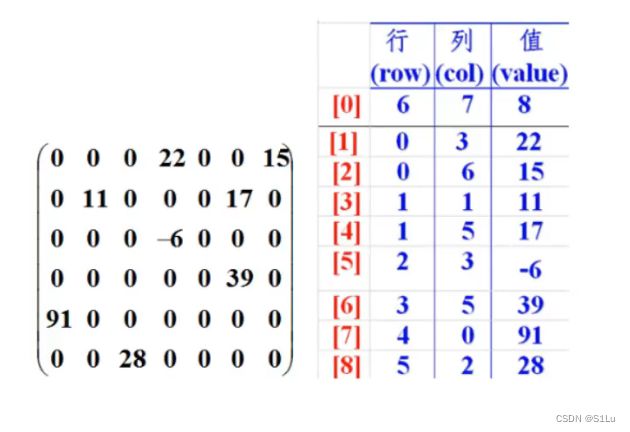04、Java数组
文章目录
- 一、数组概述
-
- 1、数组的定义
- 二、数组声明创建
-
- 1、语法
- 2、例
- 三、三种初始化以及内存分析
-
- 1、java内存分析
- 2、数组的三种初始化
- 四、数组边界
- 五、数组使用
-
- 1、for
- 2、for -each
- 六、多维数组
- 七、Arrays类
-
- 1、Arrays.toString
- 2、Arrays.sort
- 八、稀疏数组
一、数组概述
1、数组的定义
数组是相同类型数据的有序集合,每一个数据称作一个数组元素,每个数组元素可以通过一个下标来访问它们
二、数组声明创建
1、语法
/*定义*/
dataType[] arrayRefVar;
//或
dataType arrayRefVat[];
/*创建*/
dataType[] arrayRefVat = new dataType[arraysize];
2、例
package com.s1lu.array;
/**
* @Author S1Lu
* @create 2022/10/29 20:42
*/
public class Demo01 {
public static void main(String[] args) {
int[] nums; //1、定义
//或者
//int nums[];
nums = new int[5]; //2、定义数组的长度为5
//3、赋值
nums[0] = 1;
nums[1] = 1;
nums[2] = 2;
nums[3] = 3;
nums[4] = 4;
//计算总和
int s = 0;
for(int i =0;i<nums.length;i++){
s += nums[i];
}
System.out.println(s);
}
}
三、三种初始化以及内存分析
1、java内存分析
2、数组的三种初始化
- 静态初始化
- 动态初始化
- 默认初始化
package com.s1lu.array;
/**
* @Author S1Lu
* @create 2022/11/8 17:02
*/
public class Demo02 {
public static void main(String[] args) {
//静态初始化 :创建 + 赋值
int [] a = {1,2,3,4,5,6};
System.out.println(a);
//动态初始化:包含默认初始化
int[] b = new int[10];
b[0] = 10;
System.out.println(b[0]);
//默认初始化 :int类型默认为0
System.out.println(b[1]);
System.out.println(b[2]);
}
}
四、数组边界
下标的合法区间为:[0,length-1],越界报错java.lang.ArrayIndexOutOfBoundsException
五、数组使用
1、for
package com.s1lu.array;
/**
* @Author S1Lu
* @create 2022/11/8 17:14
*/
public class Demo03 {
public static void main(String[] args) {
int[] arrays = {1,2,3,4,5};
for (int i=0;i<arrays.length;i++){
System.out.println(arrays[i]);
}
}
}
2、for -each
package com.s1lu.array;
/**
* @Author S1Lu
* @create 2022/11/8 17:14
*/
public class Demo03 {
public static void main(String[] args) {
int[] arrays = {1,2,3,4,5};
for (int array :arrays){
System.out.println(array);
}
}
}
六、多维数组
- 二维数组
package com.s1lu.array;
/**
* @Author S1Lu
* @create 2022/11/11 10:03
*/
public class Demo04 {
public static void main(String[] args) {
int [][] array= {{1,2},{2,3},{3,4}};
for (int i =0 ; i < array.length ; i ++ ){
for (int j =0 ; j < array[i].length ; j ++ ) {
System.out.println(array[i][j]);
}
}
}
}
- 多维数组
七、Arrays类
其他的查看JDK帮助文档
1、Arrays.toString
package com.s1lu.array;
import java.util.Arrays;
/**
* @Author S1Lu
* @create 2022/11/11 10:07
*/
public class Demo05 {
public static void main(String[] args) {
int[] a ={1,2,3,4,5,6};
System.out.println(a); // [I@1540e19d
System.out.println(Arrays.toString(a)); //[1, 2, 3, 4, 5, 6]
}
}
2、Arrays.sort
package com.s1lu.array;
import java.util.Arrays;
/**
* @Author S1Lu
* @create 2022/11/11 10:15
*/
public class Demo06 {
public static void main(String[] args) {
int[] a ={1,3,4,2,11,6};
Arrays.sort(a); //对数组排序
System.out.println(Arrays.toString(a)); //[1, 2, 3, 4, 6, 11]
}
}
八、稀疏数组
当-个数组中大部分元素为0,或者为同一值的数组时,可以使用稀疏数组来保存该数组。
稀疏数组的处理方式是:
- 记录数组-共有几行几列,有多少个不同值
- 把具有不同值的元素和行列及值记录在一一个小规模的数组中,从而缩小程序的规模


